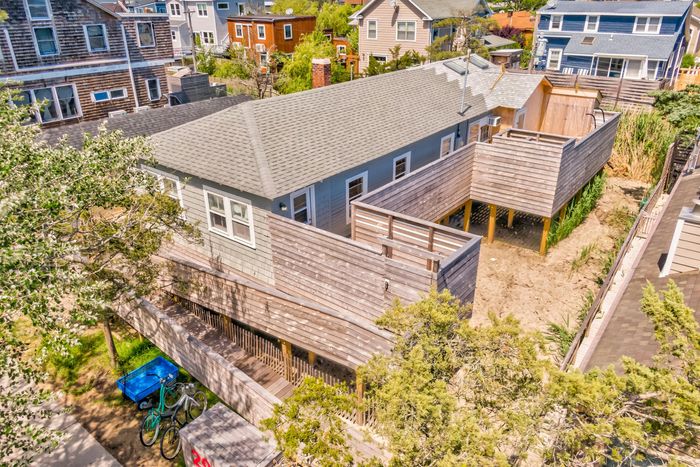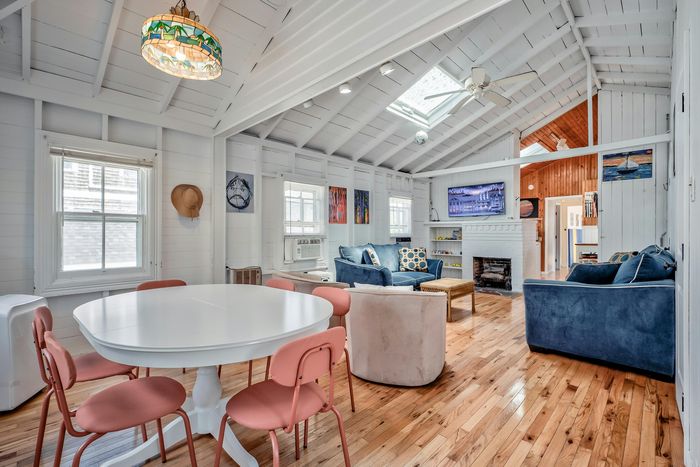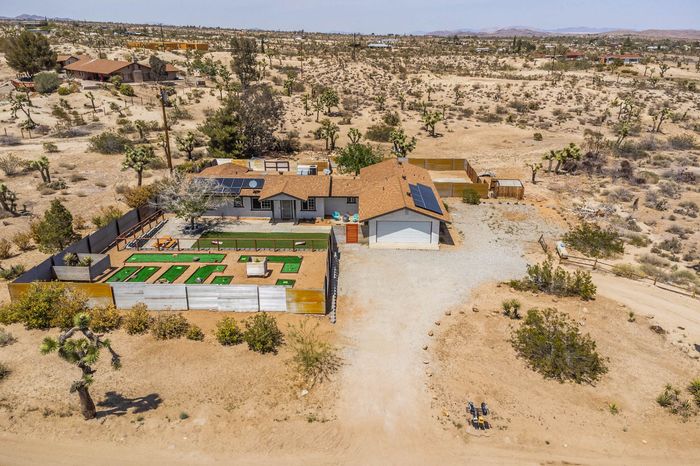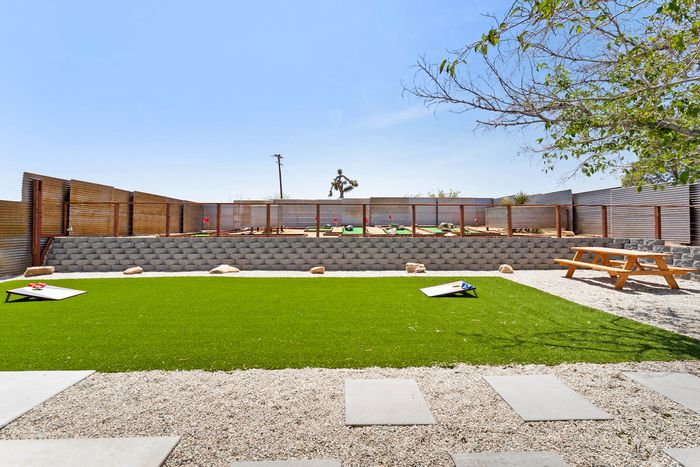The sensory gym at Spectrum House on Fire Island has areas to retreat and calm down, along with swings, padded walls, and tubes for kids seeking stimulation.
Photo: Russell Pratt
The door slammed. I heard a click and grabbed the door handle. But it wouldn’t turn.
“Unlock the door,” I pleaded.
No answer. I crouched onto the floor and peeked under it. My autistic 2-year-old son had locked himself into the master bedroom, leaving me on the outside with my husband and 3- and 4-year-old daughters. He was so close I could have touched him.
First he laughed. Then he cried. How was I supposed to explain to a 2-year-old how to unlock a door?
We were away from home in a condo in Hilton Head that we had rented for our family of five. The property owner had recently updated the condo and, as we learned at that moment, he hadn’t left a key or any tools to unlock it anywhere in the rental.
My son paced back and forth while I talked to him through the space under the door. It took 30 minutes to get a property manager to open it. My son didn’t end up hurting himself. But I knew we were just lucky.
The locks on the bedroom doors weren’t even the biggest threat. It was how easily the front door unlocked with a little push on the handle. There was no dead bolt either. As parents to three autistic children, this was unnerving. None of my kids had ever wandered out of the house before, but the possibility was pretty high. According to the CDC, about half of autistic kids run off without warning, commonly referred to as eloping. The risk of this happening while on vacation, in a strange city, was even more terrifying. It’s why the great majority of families with autistic children do not take vacations. A 2019 survey by IBCCES, an organization that offers autism certifications, found that the number was as high as 87 percent. But that’s slowly beginning to change.
At Privacy in the Palms, a three-bedroom vacation rental in Palm Coast, Florida, co-owner Suzanne Robinson added locks to the windows and doors after a friend’s autistic 4-year-old daughter walked three blocks from a rental house to the beach by herself. Fortunately someone found her and called 911 before anything happened. But Robinson knew it could have been much worse; in another case, a nonverbal autistic 4-year-old had eloped to a canal in Florida but was not found in time and drowned.
Besides installing extra security features, Robinson took the advice of a virtual assistant who was also a special-education teacher, along with feedback from parents of autistic kids. The breakables are up high, the furniture is anchored to the walls, the oven is locked, and the yard is fenced in. She also installed room-darkening blackout curtains and noise machines, and guests have access to a weighted blanket, noise-canceling headphones, and fidget toys.
Now she advises other vacation-rental homeowners through her company, Welcoming WOW, coaching them in what she calls “all-inclusive design.” It’s one of several businesses that have emerged to help make rentals more accessible and safe for neurodivergent families. While no industry-wide standards exist for “autism ready” or “autism friendly” accommodations, a couple of programs offer their own certifications. One of them, Autism Travel Club, offers a preparedness course that includes a ten-minute video and a checklist of house features, and its site features nearly 20 rentals in three states that it has certified as Autism-Ready.
A 6-foot-high privacy fence surrounds the border of Spectrum House in Fire Island.
Photo: Russell Pratt
It’s the program that John Ordover turned to when he woke up to his autistic 8-year-old son ironing the carpet in his hotel room. He resolved then to create the kind of vacation home he needed rather than wait for one to come to him. It took him two years of searching to buy a house that met his conditions: single-story, with many rooms to accommodate not just family members but also hired caregivers, and big enough to hold a sensory gym. In 2024, he opened Spectrum House. To get certified, he sent a link of his rental listing to the Autism Travel Club and answered questions about the property’s safety features, which include a six-foot-tall privacy fence and a punch-code lock that prevents people from wandering off. For Ordover, it isn’t just what he added to the house that makes it accessible, but also “what isn’t there,” he says, like ceramic knickknacks or breakable plates and glasses. Then there’s a special feature of the location that’s hard to come by elsewhere: During the summer, no cars are permitted on Fire Island.
Lorraine Woodward, the CEO and co-founder of Becoming rentABLE, another accessibility-focused vacation-rental platform, offers cognitive certification for homes designed to host neurodivergent guests. The program groups these features into four categories: sensory, lighting, safety, and scent; there are 20 in all. It might sound daunting, but it’s flexible. Rental owners can meet the certification requirements by implementing a few changes in each category — by using muted paint and décor colors (a sensory filter), installing blackout curtains (a lighting filter), and adding another set of locks to all doors leading outside (safety). The changes themselves are fairly straightforward, and Woodward says that the biggest hurdle is actually marketing; their target audience doesn’t even know cognitive certification exists.
At Spectrum House, the autism-friendly features include what’s not there, including ceramic plates and breakable knick-knacks.
Photo: Russell Pratt
For the families that have stayed at a rental billed as autism-friendly, the difference is palpable. At AUTxcapes, a Yucca Valley vacation rental ten minutes from Joshua Tree National Park, Ellen Hunja said, “It felt like the space was literally created for my family.” In 2022, she booked a vacation there with her husband and two children, including her 4-year-old autistic son. With its three different outdoor areas contained by corrugated iron fencing and an alarm system that goes off if someone leaves, Hunja could finally relax a little. “The fully enclosed and secure property was one of the biggest draws,” she said. “It’s rare for us to be able to let our son fully run wild somewhere because he elopes. Him having the freedom to go through the house and outdoor area without having to worry was amazing.” Melina Gipson, a co-owner and the community-outreach manager of AUTxcapes, said her team was inspired to create the home because the parents of the autistic kids they worked with (all three co-owners are board-certified behavior analysts) told them that going on vacation was “almost more stressful” than staying at home.
The house and grounds at AUTxscapes are all contained by high fencing to prevent elopement.
Photo: Mattie O’Neill
A mini-golf course at AUTxcapes behind the lawn is in one of three enclosed outdoor areas.
Photo: Mattie O’Neill
But perhaps the biggest draw of an autism-friendly lodging is the playroom. At AUTxcapes, the kids’ room has foam flooring with a sensory rocker and swing. There’s also a theater room with low-level, dimmable lighting; beanbags; and a cubbyhole with a cushioned area.
At Ordover’s Spectrum House, there’s even a sensory gym. Children can calm down in a “quiet corner,” swing on a platform swing, climb on foam barrels, crawl through tunnels, and get cozy in a cuddle swing. Efrat Nakash, an occupational-therapy consultant, designed it to address the range of different needs that autistic children might have; as she explained, some need “a refuge,” a place to “reset” and get calm, while others require stimulation and movement. The room has options for both.
Spectrum House’s sensory gym.
Photo: Russell Pratt
It isn’t just for young children either. When Shari Acker and her two autistic sons, who were then 11 and 14, rented Spectrum House in August 2024, she found that her “adult-sized” tween and teen both loved the sensory gym. It was the rental’s “main selling point” for her, because her children had “the same sensory needs as young kids.” Her sons especially liked swinging into the padded wall, although sometimes they would swing above the padding. She shared her concerns with Ordover, who extended the padding to the ceiling for future guests. “I would absolutely stay at Spectrum House again,” Acker said.
It’s a funny niche — one in which people like Ordover, Gipson, and Robinson wish they had more competition. “My dream,” said Ordover, “would be to have people steal this idea and set at least one house up in every resort community in the world.”






